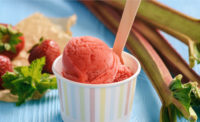Mix considerations for plant-based frozen desserts
In part one of a two-part column, we look at sweeteners, emulsification and more.

We are often asked how plant-based frozen desserts differ from standardized and non-standardized dairy frozen desserts. It sounds pretty basic; however, approaches to mix compositions can and do differ widely with varying degrees of “success.” Even as considerations for formulating plant-based mixes differ, the applicable chemistries and physics remain the same.
Well-known ice cream technologist Yogi Berra once said, “If you don’t know where you’re going, you may not get there.”
As with any food formulation, it is many times best to start at the end. What is it you wish to do? What do you want to be able to declare or say about the final food (low-fat? "high”-protein? Reduced-“sugars”? All natural? non-GMO?) What features (facts), each with associated benefits (reasons to buy), need to be considered? At what price point?
All this is related to market positioning and the strength and defensibility of that positioning. From there, principles of chemistry and physics hold as they do for frozen dairy desserts. Ingredients in the ingredient “toolbox” are different but just as complex as dairy ingredients … perhaps more so.
Plant ‘milks’ and plant ‘milk’ components
A number of nutmeat “milks” (almond, hazelnut, cashew, walnut, peanut, etc.) can be used. This includes single-strength, concentrates and dry forms, and combinations thereof.
Each set of plant “milk” solids has its own set of considerations related to management of naturally occurring enzymes, fat/oil composition, stability, functionality, and/or water-soluble “sugars” and higher-molecular-weight bulking agents. Not to mention flavor/color and water-control considerations that only get more critical under the influence of freeze concentration during whipping/freezing/hardening. Each and all of these combinations need to be carefully considered.
Sweeteners and bulking agents
A wide variety of nutritive and nonnutritive sweeteners and bulking agents are compatible with plant-based market positioning. Key, of course, is management of freezing points (and the control of the behavior of liquid water), mix viscosities, amount/quality of sweetness, and ultimate influence on body, texture, and delivery of pleasing sensory attributes at point(s) of consumption.
Emulsification of mixes
In plant-based mixes, there are no milk proteins (i.e., no micellular casein) and no milkfat to leverage to manage “classical” fat agglomeration critical to body, texture, and heat shock resistance. Thus, in plant-based mixes, much is related to mix composition, mix viscosity, and the ability to mechanically cause fat to agglomerate during whipping/freezing in the barrel of the ice cream freezer. This being said, there may not be real need for emulsification if mixes are properly formulated and assembled for subsequent processing.
Stabilization of mixes
As with other frozen desserts, it is recommended to have some sort of water-control management (i.e., control over the behavior of liquid water) during whipping/freezing, hardening, and subsequent distribution and sale. This is critical to delivering desirable body (bite/chew) and texture (smoothness/creaminess).
No surprise, in nearly all cases, classical water ices and sorbets are compatible with plant-based product positioning.
Mix flavor/color
All discussed so far need to be managed toward ultimate flavoring and coloring of any given mix. This includes flavor/color of every mix ingredient being considered and, ultimately, the flavor of “unflavored” mix. That is, the compatibility of any unflavored mix toward classical characterizing flavors such as vanilla, chocolate, vanilla-chocolate based flavors and any desirable fruit flavors (sweet-type and/or acidic-type) or combinations thereof.
That is certainly a complex topic as well. We’ll get to flavoring and coloring plant-based frozen desserts in Part 2 of this column a bit later in the year, so stay tuned or give us a holler!
Vegetable (plant) “milk”-based frozen desserts, %, dry basis*
Component |
Soy |
Almond |
Hazelnut |
Coconut |
Oat |
Plant “milk” solids |
9-10 |
< 2 |
10-12 |
20 |
10 |
Plant fat/oil** |
2-3 |
> 2 |
Varies |
Varies |
Varies |
Plant protein** |
~2 |
2-4 |
~2 |
2-3 |
Varies |
“Sugars”*** |
11-12 |
11-12 |
12-13 |
11-13 |
13-15 |
Bulking agent(s)**** |
6-7 |
8-10 |
5-7 |
6-7 |
~15 |
Stabilizers/emulsifiers |
Per need |
Per need |
Per need |
Per need |
Per need |
Total solids***** |
30-35 |
26-30 |
29-35 |
39-44 |
38-40 |
Note: Adapted from Tharp & Young on Ice Cream: Technical Short Course, Workshops, and Clinics, 2021.
*Starting formulas: Compositions vary widely based in market positioning, deliverables, and declarables; miscellaneous combinations of plant-based ingredients possible.
**Similar or different plant-based fats/oils and/or protein sources.
***Sucrose and/or other sources of sweetness; compatible with market positioning, deliverables and declarables, including reduced sugars, sugar-free, and/or reduced-, low-caloric contents.
****“High”-molecular-weight soluble bulking agents (starch hydrolysates and similar); compatible with market positioning deliverables and declarables, including potential pre-and probiotic positioning.
*****Total Solids compatible with sensory needs (flavor, body, texture), freezing point and fat agglomeration management, mix density and final overrun, yields, resistance to heat shock, etc.
Looking for a reprint of this article?
From high-res PDFs to custom plaques, order your copy today!





